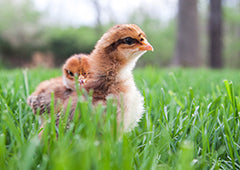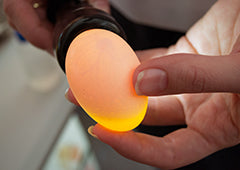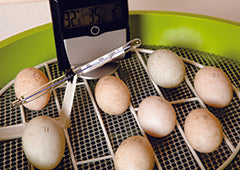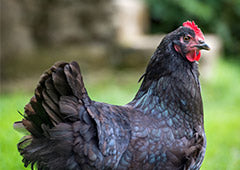Not sure whether your eggs are fertile? There are a couple of different methods you can use to see if there’s potential life inside an egg, or whether it’s simply a yellow yolk that won’t develop further.
How are chicken eggs fertilized?
In short, a fertile rooster will mount a hen and touches his cloaca with hers. This romantic moment is known as a cloacaic kiss!
Once the rooster has decided which hen he would like to mate with, he dances for her by dragging and dropping a wing and stamping his feet. Alongside this clear grab for attention, he attempts to get behind the hen. If she enjoyed his dance and felt a deep loving connection, she will squat down so that he can mount her.
The roosters seed is usually stored in the hen's storage sac until the next egg is laid and the production of a new one begins. This allows for the developing egg to be inseminated.
Interesting fact: There is research suggesting that hens can unconsciously decide whether or not to use the seed from a mate. She may be able to get rid of it if it's not to her fancy!
Find out by opening the egg
If you crack it open, a fertile egg can be identified by a small white circle on the yolk, that has a ‘bullseye’ like shape - i.e. one small white circle, with another white ring on the outside of it. This is created by a cluster of cells that, if incubated, will hopefully develop into a baby chick.
Find out by candling
If you're looking to incubate your eggs, then the only way to tell if the egg is fertile is by incubating it for a few days, and then candling the egg to see its progress.
This involves going into a dark room, and shining a bright light underneath the large end of the egg. If the egg is fertile, then you should see a dark spot around the middle of the egg, with some spider-like veins beginning to form around it.
If its not, you should just be able to see the shape of the yellow yolk inside the egg, without any signs of an embryo or veins.
Candling must be done multiple times throughout the incubation process - on Day 4, Day 10 and Day 17. This helps identify whether the fertile egg is developing as it should, or whether the embryo may have died and needs to be removed.
Don’t lose hope!
Even if you’ve bought fertile eggs from a farm or online, they may not always progress to hatching stage, or mix ups can occur - so don’t be disheartened if not all of your embryos end up developing right off the bat. It would be unusual if they all did!
If you’re incubating, check out our range of articles on the incubation process. In addition, we sell incubators that turn the eggs, monitor humidity and temperature and does its best to ensure a high hatch rate for your fertile eggs.
Once your eggs have hatched, its amazing just how quickly these little ones grow up. Alongside capturing all the memories of those first weeks, you are going to want to make sure that you've got the knowledge you need to raise a happy, healthy flock. You wouldn't want to risk making tragic mistakes that could impact their development, growth or worse!
67% of chicken keepers surveyed experienced a chicken health or behaviour issue in the first 12 months that they didn’t know how to handle. This is why I highly recommend that you check out our friends at Chickenpedia. Their Raising Baby Chicks course provides lots of valuable information to help you avoid any life-threatening accident. You'll have all the confidence to give your feathered friends the best start in life.
Get access to all of the best chicken keeping courses at Chickenpedia.



















